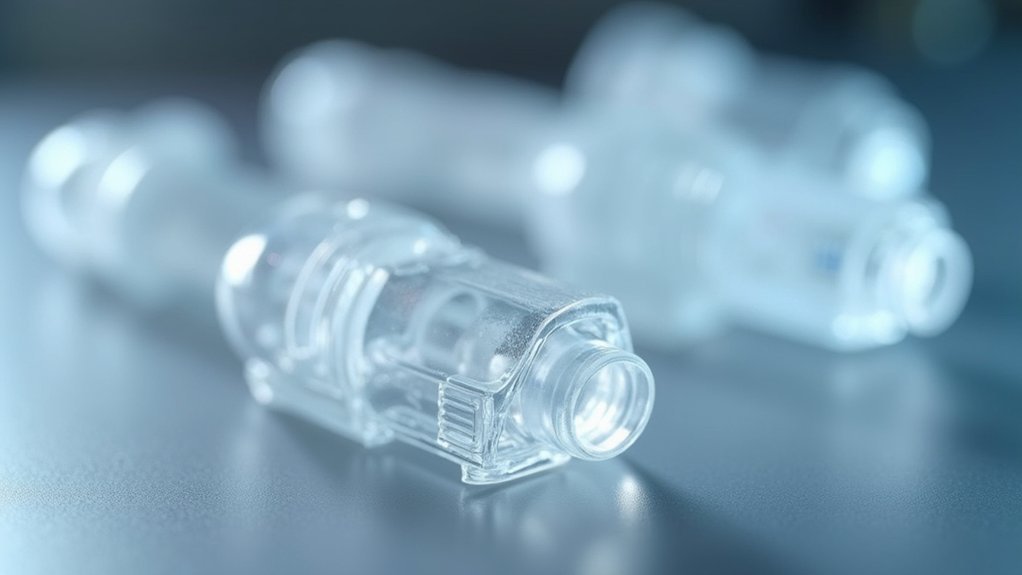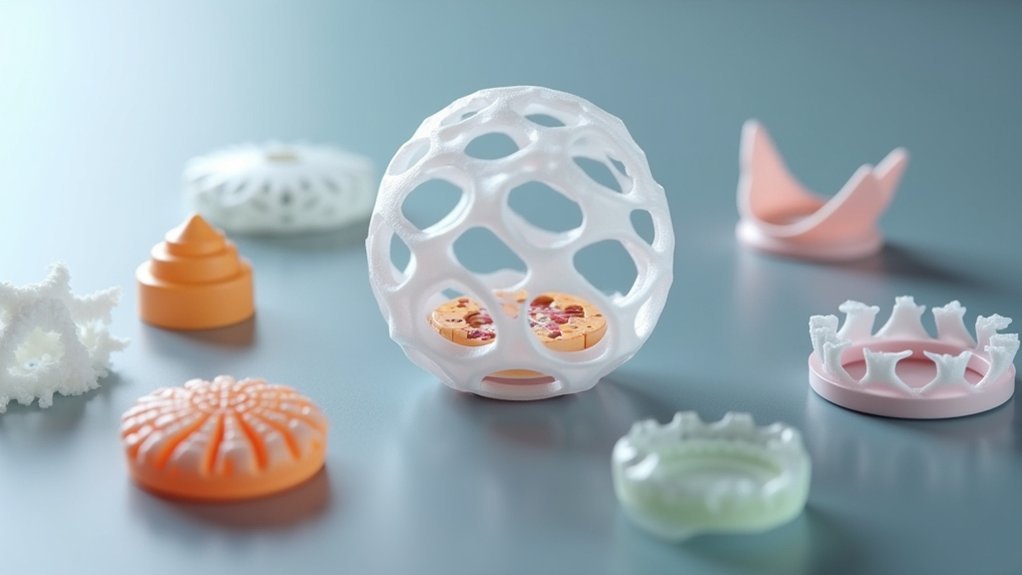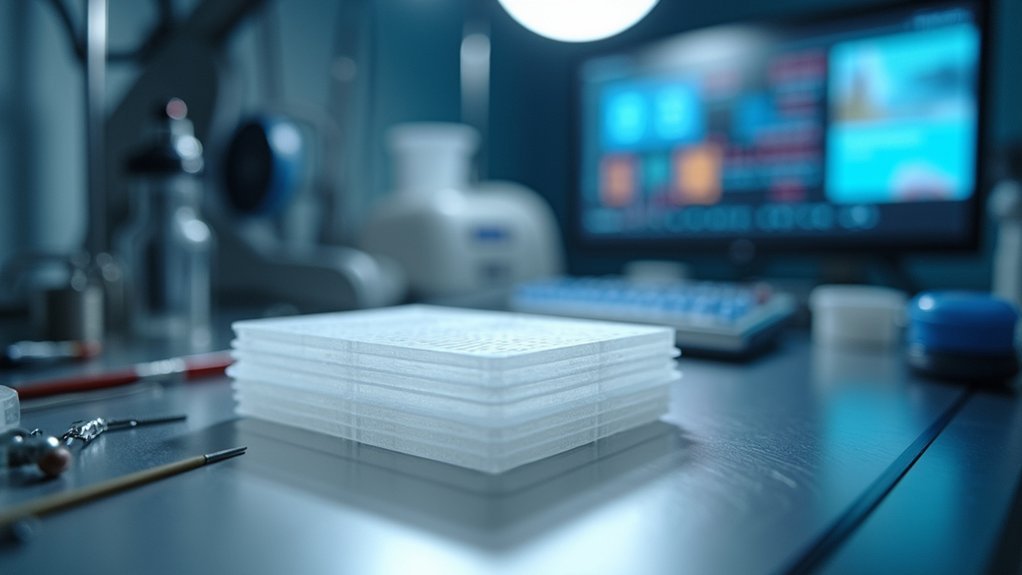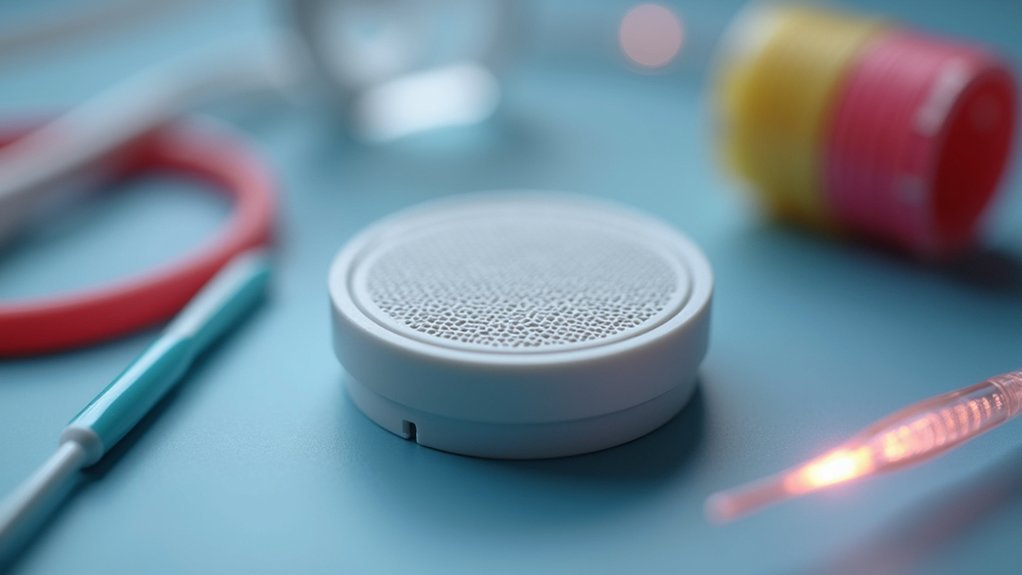You’ll find 3D printing revolutionizes medical sensor housing production through complex geometries, biocompatible materials like PEEK and PLA, and rapid prototyping that cuts development time from months to weeks. This technology delivers 15% cost savings while ensuring ISO 10993 compliance for patient safety. You can customize housings for patient-specific needs, minimize material waste, and accelerate time-to-market with on-demand production capabilities. Advanced innovations promise embedded functionality and AI-optimized designs that’ll transform healthcare solutions.
Benefits of Additive Manufacturing for Medical Device Enclosures

While traditional manufacturing methods often limit design possibilities, additive manufacturing revolutionizes how you’ll approach medical device enclosures.
You’ll create complex geometries that enhance functionality while reducing material waste through customized designs. 3D printing accelerates your prototyping phase, cutting development time from months to weeks—critical in today’s fast-paced medical device market.
You’ll benefit from biocompatible materials that guarantee safety and regulatory compliance for devices contacting human tissue.
Cost savings of approximately 15% become achievable through reduced labor and material expenses compared to traditional methods.
Additionally, additive manufacturing enables on-demand production, minimizing your inventory costs while allowing rapid response to changing market needs or specific patient requirements, giving you unprecedented flexibility in medical device development.
Material Selection and Biocompatibility Requirements
When you’re selecting materials for 3D-printed medical sensor housings, you’ll need to meet strict biocompatible material standards that guarantee safe contact with human tissue.
You must follow established cytotoxicity testing protocols like ISO 10993 to verify your chosen materials won’t provoke adverse biological reactions.
Materials such as PLA, PEEK, and silicone have proven non-cytotoxic in testing, making them reliable choices for your medical device applications.
Biocompatible Material Standards
Selecting the right materials for 3D printed medical devices requires you to navigate strict biocompatibility standards that determine whether your device will safely interact with human tissues. ISO 10993 serves as your primary regulatory framework, outlining essential testing protocols for toxicity, irritation, and sensitization assessment.
| Material | Biocompatibility Status | Common Applications |
|---|---|---|
| Chitosan | Tested, Approved | Sensor coatings |
| Gold | Tested, Approved | Electrodes |
| Silver Ink | Tested, Approved | Conductive pathways |
Modern printing technologies enable you to work with these proven biocompatible materials while maintaining manufacturing precision. Your fabrication process must incorporate materials that won’t induce adverse biological responses, requiring thorough pre-clinical testing. Continuous advancements in biocompatible materials enhance your device’s performance and safety, ensuring compliance with evolving healthcare technology requirements and regulatory standards.
Cytotoxicity Testing Protocols
Before you can deploy any 3D printed medical device, cytotoxicity testing protocols must validate that your chosen materials won’t harm living cells or tissues.
You’ll need to follow established methods like the MTT assay and ISO 10993-5 standard to measure cell viability when exposed to your materials. These protocols evaluate biocompatibility by ensuring materials don’t induce toxic effects on human tissues.
Materials like chitosan, PSS, gold, and silver ink have successfully passed cytotoxicity testing and are classified as non-cytotoxic for sensor applications.
Your materials must meet stringent requirements—they can’t just be non-toxic but must also promote cell adhesion and proliferation.
Regulatory standards like ISO 13485 mandate rigorous cytotoxicity testing throughout your development and manufacturing processes to guarantee patient safety.
Design Flexibility and Customization Capabilities

You’ll find that 3D printing transforms how you approach medical device development through its unmatched design flexibility and customization capabilities.
You can rapidly prototype sensor housings, iterate designs in real-time, and create complex geometries that traditional manufacturing simply can’t achieve.
You’re also free to select from a wide range of biocompatible materials, ensuring each housing meets both regulatory standards and your specific application requirements.
Rapid Prototype Development
Three key advantages make 3D printing’s rapid prototype development a game-changer for medical sensor manufacturing: speed, flexibility, and customization.
You’ll create functional prototypes within days rather than weeks or months using traditional methods. This rapid prototyping approach lets you quickly test sensor housing designs and make immediate adjustments based on performance feedback.
The technology’s customization capabilities enable you to incorporate patient-specific features directly into housing designs, ensuring maximum compatibility with various medical devices.
You can accommodate complex sensor technologies through intricate geometries that would be impossible with conventional manufacturing. The iterative nature means you’ll refine designs multiple times before final production, reducing overall time-to-market while enhancing functionality and usability for diverse medical applications.
Complex Geometry Creation
While traditional manufacturing constrains medical sensor housing to basic shapes, 3D printing releases unprecedented design freedom that transforms how you approach complex geometries.
You can now create intricate internal architectures impossible with conventional methods. This revolutionary capability enables:
- Integrated channel systems – You’ll embed wiring pathways and fluid channels directly into housing walls, eliminating separate assembly steps.
- Organic curves and lattice structures – You can design biomimetic shapes that conform perfectly to anatomical requirements.
- Multi-functional geometries – You’ll combine mounting features, protective barriers, and ventilation systems within single components.
- Microscopic precision details – You can incorporate tiny ventilation ports and sensor alignment features with exact dimensional control.
This geometric freedom lets you optimize medical devices for specific applications while maintaining structural integrity and aesthetic appeal.
Material Selection Options
Beyond geometric freedom, your material selection fundamentally determines how well your medical sensor housing performs in clinical environments.
With 3D printing, you’ll access diverse materials like PLA for basic prototyping, ABS for enhanced durability, and TPU for flexible applications requiring impact resistance.
You can select advanced composites that deliver superior mechanical strength and thermal stability, essential for sensors operating in demanding medical conditions.
Bio-based polymers offer sustainable alternatives without compromising biocompatibility standards.
Your material selection process becomes strategic when you consider varying wall thicknesses and internal structures.
Each polymer brings distinct properties—some prioritize chemical resistance while others emphasize sterilization compatibility.
This flexibility lets you match material characteristics precisely to your sensor’s operational requirements and regulatory demands.
Rapid Prototyping for Healthcare Applications

When you’re developing medical devices, rapid prototyping transforms how quickly you can move from concept to functional testing.
3D printing enables you to create customized sensor housings tailored to specific patient needs while dramatically reducing your design-to-production timeline.
This revolutionary approach offers several key advantages:
- Accelerated iterations – You’ll receive faster feedback from real-world testing, allowing immediate design modifications.
- Cost reduction – You’ll minimize material waste and streamline production of complex geometries that traditional manufacturing can’t handle efficiently.
- Biocompatible safety – You can use materials that guarantee patient comfort and safety during skin contact.
- Embedded functionality – You’ll integrate sensors directly within housings, creating multifunctional devices that monitor essential signs in real-time.
Rapid prototyping fundamentally changes your development process.
Quality Control and Regulatory Compliance Standards
As you shift from rapid prototyping to production-ready medical sensor housings, stringent quality control measures become your primary defense against regulatory setbacks and patient safety risks.
You’ll need to implement rigorous biocompatibility testing, verifying materials like chitosan, PSS, gold, and silver ink are non-cytotoxic for human tissue contact.
Your regulatory compliance strategy must align with FDA and ISO 13485 certifications, establishing quality management systems that meet medical device standards.
Your regulatory compliance framework must establish robust quality management systems that meet FDA and ISO 13485 medical device certification standards.
You’ll maintain thorough documentation and traceability protocols throughout your supply chain, enabling full product accountability.
Continuous monitoring validates your printing parameters—temperature, layer adhesion, and material consistency—while regular regulatory audits assess your compliance measures.
This systematic approach guarantees your 3D printed medical sensor housings meet both safety and efficacy requirements before market release.
Cost-Effectiveness in Small Batch Production
While traditional manufacturing demands substantial upfront investments in tooling and molds, 3D printing transforms your approach to small batch production by delivering immediate cost advantages.
The cost-effectiveness of 3D printing becomes particularly evident when you’re producing limited quantities of medical sensor housings.
Here’s how 3D printing maximizes your return on investment:
- Reduced Production Costs – You’ll achieve approximately 15% cost reduction compared to traditional manufacturing methods.
- Minimized Material Waste – Additive manufacturing eliminates excess inventory concerns that inflate small batch costs.
- Accelerated Time-to-Market – Lead times drop from weeks to days, enhancing your market responsiveness.
- Local Material Sourcing – Transportation costs and carbon footprints decrease when you utilize nearby materials.
This combination enables rapid prototyping and design iterations without expensive tooling changes.
Future Innovations in Sensor Housing Technologies
The cost benefits you’re experiencing today represent just the beginning of what’s possible in sensor housing manufacturing.
Current cost savings in sensor housing production are merely the foundation for revolutionary manufacturing breakthroughs ahead.
Future innovations will transform how you approach medical device production through advanced 3D printing technologies and biocompatible materials that guarantee long-term implantation safety while minimizing immune responses.
You’ll soon access complex geometries impossible with traditional manufacturing, enabling better anatomical integration and enhanced functionality.
Flexible, lightweight materials will improve patient mobility and comfort in wearable monitoring devices.
Smart housing features will embed temperature and pressure sensors, providing real-time performance data that enhances patient outcomes.
AI and machine learning algorithms will optimize your design processes, creating more efficient and tailored healthcare solutions that adapt to diverse patient needs through intelligent manufacturing approaches.
Frequently Asked Questions
What Are the Negatives of 3D Printed Houses?
You’ll face weather delays, limited builder expertise, public skepticism about durability, comfort concerns with concrete structures, and ongoing technology challenges affecting material selection and design efficiency, potentially increasing costs and construction timelines.
How Much Does It Cost to 3D Print a House?
You’ll spend between $10,000 to $400,000 to 3D print a house, with most typical single-family homes averaging around $200,000. You’ll save approximately 15% compared to traditional construction costs.
How Long Will a 3D Printed House Last?
You’ll get 50 to 100 years from your 3D-printed house, depending on concrete quality, environmental conditions, and maintenance. You’ll extend its lifespan with protective coatings and regular upkeep.
How Much Does Medical 3D Printing Cost?
You’ll spend $20-$50 per kilogram for basic materials, but specialty materials exceed $200. Equipment costs range from $2,000 to $100,000, while finished units cost $5-$50 versus traditional manufacturing’s $100-$1,000.





Leave a Reply